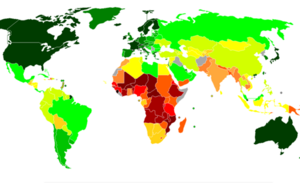So, on the global scale 0-1 and taking account of life expectancy, life expectancy at birth, measures of education and GDP per person, what scores would you expect for the Baltic Sea countries? Write it down – I will give you the figures calculated by the UN Development Programme later in the blog. In fact, if you are in the mood, you can also guess at what the life expectancy of a child born in 2007 would be for each of the countries: Estonia, Denmark, Finland, Germany, Latvia, Lithuania, Norway, Poland and Sweden. Then, just for comparison guess what the same figure might be for China, India and Malawi.
Ecological footprint
The second key measure is a country’s ecological footprint. The basic idea will be familiar to many readers. As the website of the Global Footprint Network (www.footprintnetwork.org) says, “It measures how much land and water area a human population requires to produce the resources it consumes and to absorb its wastes, using prevailing technology.” The calculations show that globally the footprint is 1.4. In other words it takes the world about 17 months to produce and absorb what we use / dump in 12 months. This means that we are operating in ‘overshoot’ mode, living on past legacies or mortgaging the future to sustain existing lifestyles and patterns of consumption.
The footprint of a country or region measures all the cropland, grazing land, forest, and fishing grounds required to produce the food, fibre, and timber it consumes and to absorb the wastes it emits. In 2003 the European Union’s Ecological Footprint was 2.26 billion global hectares (gha), or 4.7 gha per person. A global hectare is a hectare with world-average ability to produce resources and absorb wastes. As Europe’s total supply of productive area, or biocapacity, in the same year was 1.06 billion gha, or 2.2 gha per person, it is clear that Europe as a whole is in debit on this measure. We manage this by importing goods and services and exporting waste, including CO2. If all the world’s citizens lived in the same way that we do in Europe, we would need more than two and a half planets to provide the necessary resources, absorb our wastes, and leave some capacity for wild species. We in the EU are 7.7 per cent of the world’s population but we contribute 16 per cent of the present global ecological footprint.
Now let’s do the similar questions as for the HDI. If the world’s average biocapacity available per person is 1.8 gha, what do you think the footprint is for each of the BSR countries? Remember that the world figure is an average, so that, for example, countries that use more energy per head than the earth’s average are likely to score higher than that.
Estonia 0.883; Denmark 0.955; Finland 0.959; Germany 0.947 (same as UK); Latvia 0.866; Lithuania 0.870; Norway 0.971; Poland 0.880 and Sweden 0.963. Norway is actually the HDI World League Champion, with Sweden at number 7 in the world. Lithuania is 46 and Latvia 48 – still part of the grouping that UNDP describes as having ‘High Human Development’.
Estonia 72.9, Denmark 78.2, Finland 79.5, Germany 79.8, Latvia 72.3, Lithuania 71.8, Norway 80.5, Poland 75.5 and Sweden 80.8. Then other figures are China 72.9, India 63.4 and Malawi 52.4.
Thus the picture that emerges is that despite differences between them, all the BSR countries actually do well in global terms on the HDI. The countries ranked 159 and below come in with HDI scores of less than 0.5. Of course, the figures are national averages and cover regional differences so differences between east and west within Germany, for example, are not picked up.
The ecological footprint scores are in Estonia 6.47, Denmark 5.75, Finland 7.64, Germany 4.55, Latvia 2.59, Lithuania 4.44, Poland 3.29 and Sweden 6.07. Apologies to the Norwegians but the report I was reading is about the EU!
These figures can be looked at in different ways. On the one hand the high Scandinavian scores in particular show citizens in those countries consuming much more than their ‘fair share’ of the earth. On the other hand, some of these countries also have a much larger national endowment of these resources in relation to their population numbers. Viewed in this way, Sweden and Finland (but not Denmark) are ‘creditors’ rather than ‘debtors’. Latvia is also in credit on this measure.
It is important to stress that the figures are not static. Obviously, a rise or fall in population numbers influences any per capita measure. However, so does the ecological efficiency with which a country goes about its business, along with the lifestyles of its people. Germany is interesting in this respect. By reducing the amount of coal it uses and taking a positive stance towards development of renewable energy technologies, it has been able to stabilize its footprint while increasing in population numbers. However the footprint per person is still double the world average.
China, as always, is fascinating. In 2003 its footprint was 1.6gha per person – in other words below average and ranking number 69 in the world. However, the sheer scale of its CO2 emissions made it a debtor country rather than a creditor. This is where the connection to the HDI measures become significant. Countries with high HDI scores enjoy a standard of life that others legitimately aspire to. How can they achieve this without a similar escalation in their ecological footprint? Certainly, a low HDI is no way to solve the ecological problem. If you look at the data for sub-Saharan African countries with low HDI scores, the good news is that the gha per person levels have been stable or even declining, in marked contrast to the pattern in most EU countries. They are creditor countries. However, their biocapacity is falling even more sharply, so things are getting worse in real terms.
Looked at the other way: can the high quality of life that the BSR countries now enjoy be sustained if their ecological footprints cannot be reduced?
These are all national figures and much depends on national governments, business and consumers. However, local governments also have a part to play in the attempt to deliver a high quality of life alongside an acceptable ecological footprint. How and where we build houses matters. The Global Footprint Network strongly argues for more compact urban forms rather than the dispersed development pattern that is common in some of the Baltic Sea countries. This would help to shorten per capita travel distances, and therefore energy consumption and emissions. It also conserves productive land or forest reserves that help absorb CO2. Local governments can also encourage and support individuals to think through the footprint consequences of their own consumption patterns. This may involve more and better recycling, less waste, more care for water use, local food networks etc. In the end the details will vary form place to place. However part of the starting process is developing a system of local accounts. Are there innovators in the IC Network who could take a lead on that?

